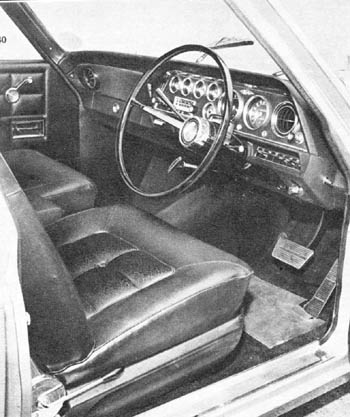

Mk IV Pages |

Full throttle acceleration in D1 gave change-up speeds of about 22 and 55 m.p.h.
These are below the designed figures, which should be 32-36 and 60-64 as confirmed
by other automatic Zodiacs in the group taken to Tunisia. The kick-down speeds
at full throttle should be about 2 m.p.h. below the maximum change-up speeds.
The gear-selector on our car could have been more positive. When we changed to a manual Zodiac we found it was faster and accelerated better than the automatic one. It reached 102 m.p.h. quite quickly and pulled really hard in the middle rpm. range. In this respect the advantage of the extra half-litre as compared with the Zephyr 6 engine could be felt. Even so, the Zephyr 6 we drove in Tunis had plenty of performance and would top the 100 m.p.h. Both Zodiacs and Zephyrs very stable directionally and neither camber nor ridges along the edges caused the cars to wander, the strong winds scarcely affected them. What we at first took for directional vagueness proved to an impression gained from the geared steering which has a sloppy feel around the centre point, with too much ineffectual movement of steering wheel. Towards the locks the steering quickens and taking a positive steering action the car controlled quite precisely. The present sealing of the doors and windows is perfectly satisfactory for its primary purposes, but is thought to be responsible for external wind noise, which becomes too loud at high cruising speeds. Otherwise, the Zodiacs in particular were a lot quieter than the models they replace. Comfort is noticeably improved too; the Zodiac seats are thickly padded and "dead" sprung so ride was smoother, apart from fact that the new suspension gave more level progress. The absence of roll and of sideways movements of the tail over rough roads contributed a lot to the stability and comfort of the occupants. For the first also there is leg and foot room to spare in the back of a big Ford. One or two sections of road in Tunisia were still being made and it was over these that the real advantages of the i.r.s. became apparent. The cars held a steady course, hands-off, with no hopping about at the back, with pretty good suspension damping, and at no time did our car bottom (carrying 3 people and luggage). Although North Africa was not hot three weeks ago, there were sufficient heat and humidity to exercise the ventilation system. Below 40 m.p.h. there is little ram effect but the rather noisy booster fan or very fast) churns the air through the face level the ducts very well. At higher speeds plenty of fresh ram air floats through the face-level ducts. The screen wiper blades are long and efficient and gave a clean sweep and even pressure at over 80 mph. We finished our days of driving fresh and relaxed, which speaks well for the cars. There were no break-downs in over 15,000 miles of communal driving and no single car used more than one pint of oil uring the two days of testing. |

Zodiac Automatic 2994 c.c. Driving impressions by the Editor, "Autocar" 22 April 1966 |
ONE way of getting to know a new car is to pound it south over the not always good
roads extending from Tunis on the Mediterranean coast of Africa to the edge of
the desert proper, and back again. This we did with the new 6-cylinder Fords,
covering some 630 miles in two days. The few main metalled roads have long undulating straights with unmade edges; while we were there they were buffeted by fierce winds. Storms and wind together caused wash-outs where normally dry stream beds crossed the road and there were some sand-drifts. There is practically no traffic, and we were able to hold over 90 m.p.h. for long periods on some desert roads, both Zephyr and Zodiac showing how rapidly they can cover long distances. Our first car was a Zodiac with automatic transmission, export suspension and tyres blown up to 28 psi. for fast, hot driving. Only recently run-in, it was less lively than we had expected and would not reach 100 m.p.h. The automatic changes were smooth and sweet, and the maximum kick-down speed was only 54 m.p.h. We decided that this car was not representative from the performance point of view and that the hard tyres and stiffer suspension were detracting from the ride and causing vibration through the body. The engine was always smooth and mechanically quiet, such sound as was heard at high rpm. seeming to come from the fan and perhaps the air intake. A gentle, easy-going engine, this three-litre was over its power peak and beginning to run out of breath well before the red section of the rpm. indicator was reached. |
This is the automatic version of the new Zodiac. There is a rev counter. separate
gauges for fuel, oil pressure, water temperature and battery current, and the
speedometer has a trip mileage recorder. Reclining front seats are standard |